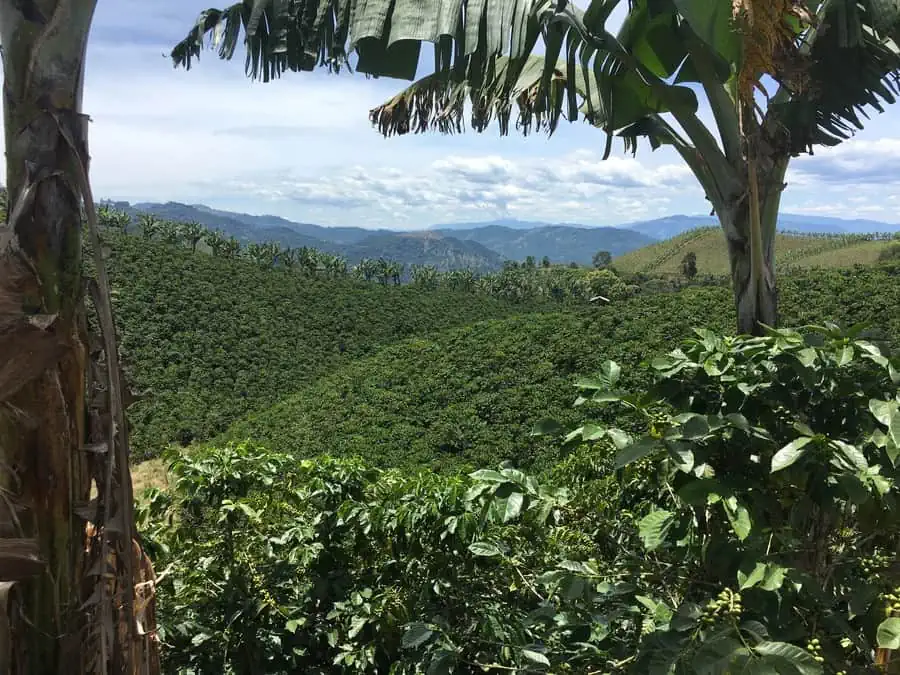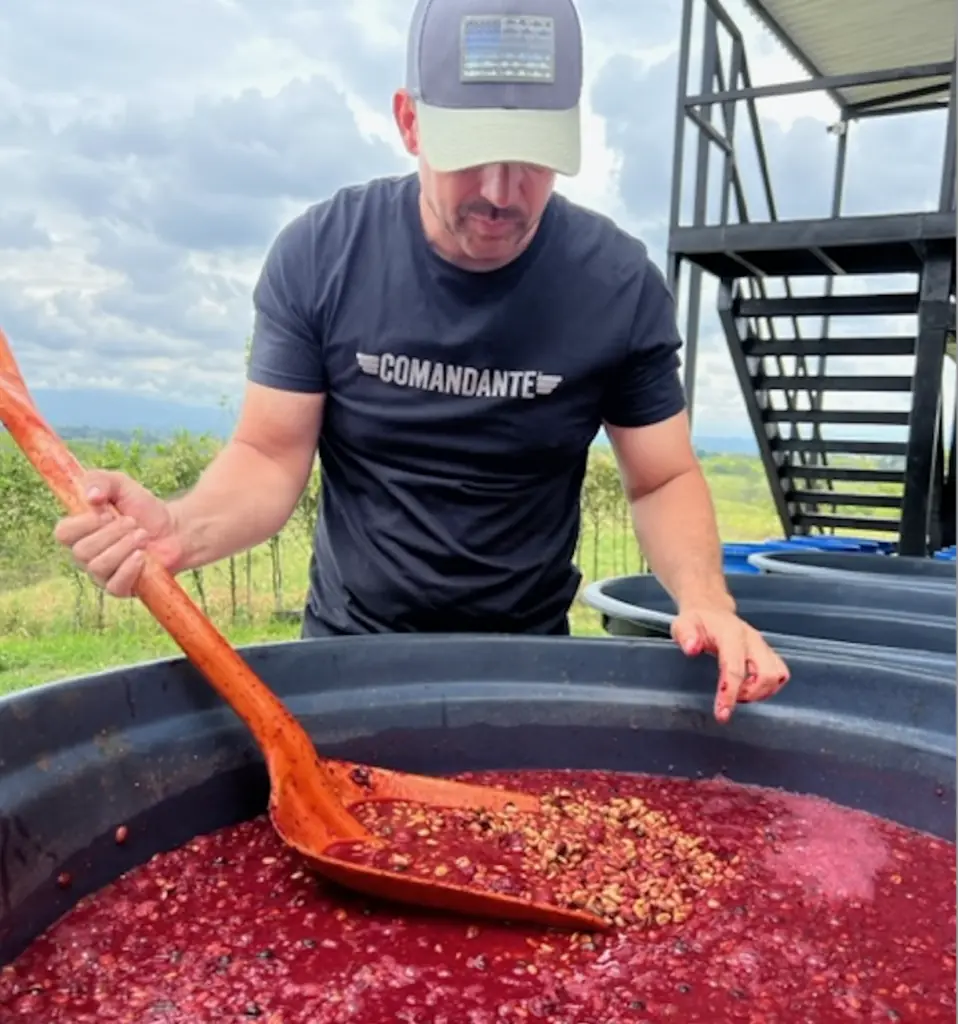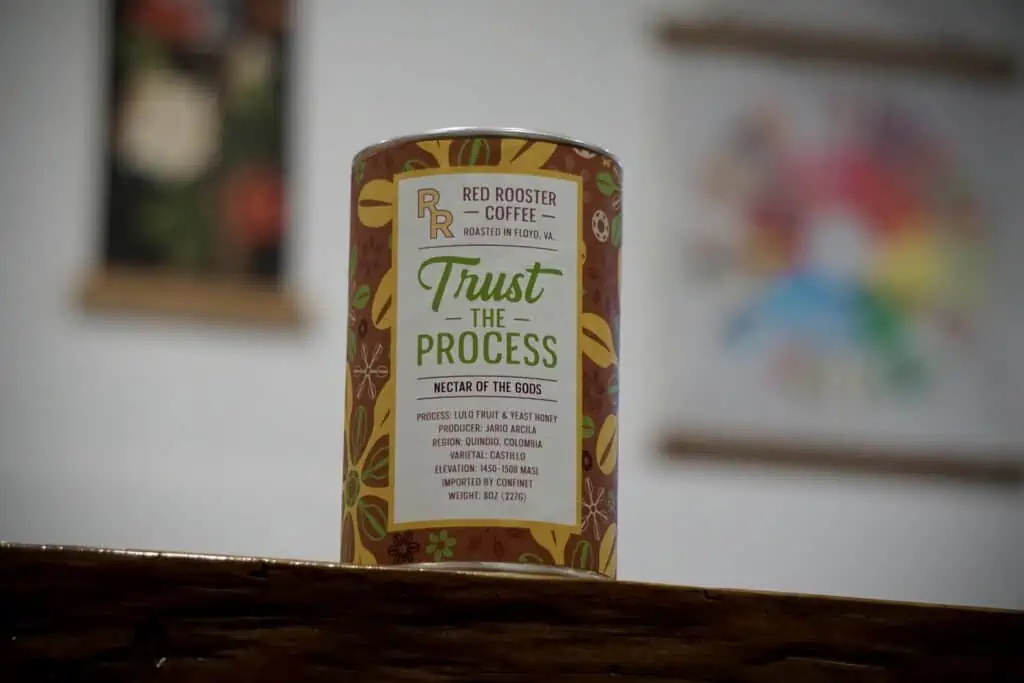
Finca La Loma in Costa Rica’s Tarrazu growing region. Courtesy of David’s Nose.
At the experimental tip of the specialty coffee world, the excitement never stops. The latest processing twist from Colombian and Central American coffee growers involves putting natural fruit, herbs or spices into the fermentation tank with the coffee during processing. The fermentation tanks are usually sealed, making this fermentation anaerobic as well. Readers of our March 2023 report know that anaerobic fermentation tends to create tangy sweet (sometimes very tangy sweet) profiles with surprising flavor notes. The most extreme anaerobics can be excessively sweet with artificial-tasting, cologne-like flower and candyish notes. But we also learned with that March report that not all coffees processed this way go over the edge into cologne/candy territory. Many are extraordinary profiles that may offend purists, but are balanced and complete, profiles that read as coffee, yet exceptional and original coffee.
In this latest report, we tiptoe on into the next, more controversial processing frontier: anaerobic-fermented coffee that also has had fruit or spice added to the sealed tanks during fermentation. In some cases, the fruit may be familiar to North Americans. Various red fruits, including strawberries, were deployed in Korean roaster Prism Coffee Works’ El Vergel Rojo Fruit Infused, reviewed here at 93. With other samples, the fruit was less familiar, as with the 94-rated Colombia Santa Monica Castillo Honey Lulo from Virginia-based roaster Red Rooster, in which tart little fruits Colombians call lulo were added to the tank.
Names assigned to fruit-added processing methods vary — fruit infused, co-fermented, fruit macerated, additive fermented — possibly a symptom of the controversy that has developed around the practice in the specialty coffee world. That controversy also may have contributed to the relatively few samples we received for this report: 26 samples from 15 roasters (six U.S.), as opposed to the 90 samples from 90 roasters that filled our lab when we sent out a call for the straightforward anaerobic coffees (no additives) for our March 2023 report.
Nothing Like the Old Flavored Coffees
Before getting into the controversy part of the story, however, one important point needs to be made: These coffees do not resemble the old, once-popular artificially flavored coffees. Here, nothing intrudes on the character of the coffee as explicitly as did those artificial flavors with their cloying pop-culture nature and metallic finish. In fact, I found it difficult to identify the specific fruit added to the tank, even if I knew the name and was generally familiar with the taste of the fruit. I would get fruit, yes, but nail the specific identity of that fruit? Close to impossible.

Co-fermenting coffee cherries with raspberries at Finca Campo Hermoso in Colombia. Courtesy of Jared Hales, Hacea Coffee Source.
Recall that the fruit is added as an integral part of fermentation, a complex chemical process the details of which remain relatively unstudied. In other words, these coffees are not the result of a simple additive process. They don’t take already processed coffee and add already processed fruit to it. The fresh fruit and fresh coffee react together to create a unique chemical event. Certainly, this explains the complexity of the fruit sensations that emerged in surprising and unpredictable ways in these coffees.
And the Controversy …
Nevertheless, producers who add fruit to the tank are being accused of cheating on the implicit rules of fine coffee. The Cup of Excellence (COE), for example, which manages a series of highly respected juried green coffee competitions, prohibits addition of fruits, spices or other nontraditional ingredients to coffees entered in their competitions. The World Barista Championships include a regulation with a similar broad intent.
How many roasters share this position? It’s hard to say, but the relatively lukewarm response to this report could suggest that many roasters are not yet all in with this latest processing innovation. On the other hand, they may simply be approaching it with caution and deliberation.
Enthusiasm and Reservations
True, some roasters seem sold. Caleb Walker of Montana’s RamsHead Coffee Roasters, whose Colombia Campo Hermosa Co-Fermented Honey (93) showed a particularly intense, juicy brightness, reports, “Personally, I am really enjoying fruit-infused coffees. The unique process of fruit infusion brings out a brightness that is difficult to find in a standalone natural. The fruit infusions seem to add another dimensional layer of flavor to the cup profile.”

Virginia’s Red Rooster Coffee Roaster submitted Colombia Santa Monica Castillo Honey Lulo, a coffee co-fermented with lulu fruit. Courtesy of Tony Greatorex.
More typical, however, was ambivalence. “More often than not, I am not a fan of these coffees — I find them to taste and smell artificial … and sometimes they are just downright bad. Unique, sure, but also unpleasant,” writes Haden Polseno-Hensley, co-owner and co-founder of Red Rooster Coffee. But Red Rooster definitely makes exceptions for the best of these coffees, including this month’s Colombia Santa Monica Castillo Honey Lulo, a strikingly original coffee comprehensively summed up by co-cupper Kim Westerman as delicately fruity, tartly floral, richly musky and enigmatically savory.
And although Youngjun Cho of Korea’s Prism Coffee Works complains that “many [fruit fermentations] have a strong artificial flavor and do not taste like coffee,” he found a persuasive exception in his 93-rated El Vergel Rojo Fruit Infused, which showed a striking juxtaposition of sweetness and umami in the structure, supporting flowers and berry on the sweet side and salted caramel on the umami. “These are great ‘fun’ coffees for beginners,” he concludes.
Starter Coffees?
The appeal of these coffees for coffee beginners and jaded regulars was a common theme running through roaster comments. Ted Stachura of California-based Equator Coffee, whose Colombia Las Flores Mint Macerated (93) was one of my personal favorites, with its herbs, flowers and deep but tactful sweetness, writes, “I see these co-fermented coffees as an avenue to excite the palates of even the most casual coffee drinkers. While it may be difficult for the average coffee consumer to detect subtle flavor nuances in traditionally processed coffees, there is no mistaking the flavors in the fruit-/spice-infused coffees we have recently been introduced to. My hope is that these creatively fermented coffees can be a gateway for weary coffee drinkers to start thinking about our favorite beverage in new ways.”
The Anaerobic Impact
What struck me most about the sensory character of these infused coffees, however, was how important the impact of anaerobic processing was to their originality, more important perhaps than the added fruit or spice. With the best of these coffees, the fruit infusion encouraged attractive and intriguing aroma/flavor complications, certainly, but the underlying structural originality of most of these profiles seemed ultimately driven by their tangy lactic-acid structure, the result of anaerobic fermentation. The fruit mainly contributed additional aromatic complication and originality.
For example, Gary Liao of Taiwan’s GK Coffee submitted a coffee that was co-fermented with fruit but not anaerobically fermented. Passionfruit was simply combined with the freshly pulped coffee in a conventional open-top fermentation tank during traditional wet processing of the Colombia Finca Monteblanco Purple Caturra Passionfruit Washed (92). The result is a smooth, intriguing coffee, but not as original or striking as most of the other co-fermented coffees. It impresses with a quite satisfying but rather classic profile driven by tart fruit and almond notes.
The Latest Producer-Driven Innovation
This practice of adding fresh fruit or herbs to the fermentation tank is, of course, just the latest in a string of product innovations pioneered at the farming end of the coffee supply chain, rather than at the consuming end. Until around 2004, the innovations in coffee that got consumers involved and excited all originated in the consuming context: selling whole bean coffee out of bins, for example; roasting all coffees dark; the complex innovations of espresso cuisine; and the infamous artificially flavored coffees mentioned earlier. In all of these cases, good, consistent-quality coffee was simply the raw material for changes wrought by city-centered roasters and cafes, most in North America and Europe.
Things started changing around 2004, when producers began selling high-quality natural, or dry-processed coffee rather than the usual clean wet-processed types, kicking off a whole sequence of innovations in processing designed to excite consumers and satisfy our apparent need for novelty: natural processing, honey processing, various versions of anaerobic fermentation, and now fruit infusion. At the same time innovations in variety, led by the revelation of Geisha/Gesha in 2004, similarly shifted the locus of innovation from consuming to producing context.
A Plus for Producers?
The fact that this latest coffee style was pioneered by coffee farmers or producers has been taken as a continued indication of the new importance of producers and producing countries as centers for change and innovation in coffee. This is true, and for those of us who, for various reasons, political and aesthetic, tend to pull for producers and the Global South, a happy development. What may be arguable is whether co-fermentation is, in the big picture, a positive development for a wide range of producers. It certainly highlights producers as artists and innovators and helps focus consumers on their contributions and importance.
But, as more than one submitting roaster pointed out, what exalts the creativity of some well-positioned producers with good connections may not help less-fortunate producers stuck at the end of a bad road. Achieving good results with earlier innovations, like natural and honey processing, requires knowledge and care from the farmer, but not quite the meticulous control demanded by anaerobic processes.
Euphora Coffee’s May Wang points out: “Adding fruit during coffee cherry fermentation can have an impact, but it requires extensive research and experiments to determine how it affects the flavor characteristics of coffee. The fruit fermentation method necessitates careful control of all controllable variables for producers, which may result in increased labor costs. In the world of fermentation, microorganisms and sugar molecules must interact in a very specific way to achieve a thorough transformation of the content. Failure to monitor external variables such as temperature and oxygen levels could lead to the production of poor-tasting coffee beans.”
Polseno-Hensley of Red Rooster adds: “I believe processes like [co-fermentation] are based on producers feeling that they are forced to innovate, largely due to the fact that growing exotic and delicate high-elevation varietals is getting more challenging because of climate change. Small producers are turning to the idea of additives in processing to enhance the fruit and acidity of heartier disease-resistant varieties that would not normally fetch such high prices.”
Also, we in North America often carry around a mental picture of “coffee producer” as a fellow in a white shirt and sombrero from Central or South America, whereas coffee producers range from isolated villagers high in the mountains of Papua New Guinea to all-women co-ops in northern Sumatra to industrialized Brazilian farms. Whether the wider community of coffee producers gradually buys into these new possibilities will determine their long-term impact on the coffee world.
A Last Note
Those outside the specialty coffee tradition probably don’t grasp how ambivalent many of us feel with respect to co-fermented coffees. We support creativity and excitement, but for many of us, the notion of altering the basic taste profile of coffee, sometimes rather radically, by combining coffee with other non-coffee stuff is disturbing, even when accomplished with the subtlety displayed by this month’s coffees. The stubbornness with which the rules committees of the two leading coffee competitions (COE and WBC) resist allowing co-fermented coffees to compete in their events suggests, I think, the persistence of this fundamental unease. Are we considering the excellence of coffee production from tree to bean as a coherent act of tradition and passion, or are we are we simply celebrating cute tricks at the end of that process?
Difficult to say, of course. Probably best to enjoy the rich vein of ambivalence running through roaster comments this month and, above all, experience the answers proposed by the nine excellent co-fermented coffees we review here.
Thanks to the roasters who greatly enriched this report by sharing their ideas and experience regarding anaerobic coffees: Youngjun Cho, prism coffee works, Korea; David of David’s Nose Coffee, Taiwan;Tony Greatorex, Red Rooster Coffee, USA; Gary Liao, GK Coffee, Taiwan; Haden Polseno-Hensley, Red Rooster Coffee, USA; Ted Stachura, Equator Coffee, USA; Caleb Walker, RamsHead Coffee, USA; May Wang, Euphora Coffee, Taiwan; Van Wang, Riika Café, Taiwan.













